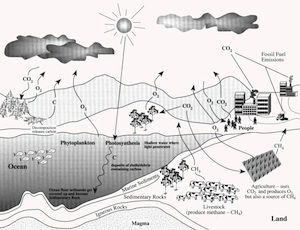Carbon in the Atmosphere
Carbon Cycle – Historical Context
Human civilization developed under natural levels of greenhouse warming. But human activities are now causing extra carbon to go into the atmosphere.
| Carbon Cyle Before Industrial Revolution |
The carbon cycle functioned in relative balance before impacted by human activity. Carbon dioxide was emitted to the atmosphere by volcanoes and exchanged between the atmosphere, geosphere (vegetation and soils) and the hydrosphere (oceans). |

Click to enlarge |
Carbon Cycle After Industrial Revolution
All these exchanges continue but human emissions from fossil fuels use has perturbed the cycle. As humans add carbon dioxide to the atmosphere between half and two thirds of it is currently absorbed by the oceans and land plants in carbon 'sinks' so that the atmospheric increase in carbon dioxide is greatly mitigated by nature. This process acidifies the oceans and causes some plants to grow faster. The fluxes into these carbon sinks may become reduced as they become saturated. Land plants are growing back from centuries of deforestation (which will end soon), and the oceans are becoming more acidic, which will reduce the ability of microrganizsms to make carbonate shells. As the oceans increase in temperature, the solubility of CO2 will decline. Thus the 'discount' we get from thee sinks will disappear in the future. |

